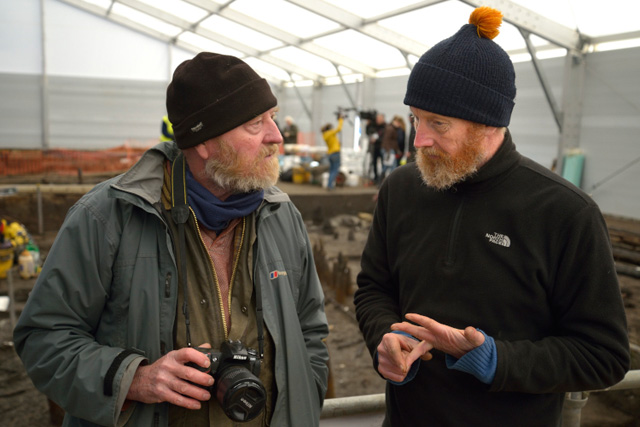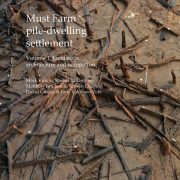Dig Diary 20: Excavating in the Fenland Landscape
March 7, 2016
The Importance of Research in the Flag Fen Basin
The Must Farm settlement excavation is the most recent in a landscape where archaeological projects have always been at the forefront of prehistoric research. This is an area of the country where excavations pioneered new techniques and approaches that have helped to redefine and refine our understanding of prehistory. The amount of development that goes on in this part of the Fens and its favourable preservation conditions offer us a unique and invaluable window into the past.
It is important to consider the significance of previous projects and their continued role in developing an understanding of a prehistoric landscape: not simply a series of sites. This blog post is a brief introduction to the archaeological work that has been carried out within the Flag Fen basin. One of the best aspects of these projects is that the information from them has been made very accessible in a series of readily available books.
As mentioned in previous site diaries the Flag Fen basin is one of the most significant locations for the discovery and understanding of Bronze Age archaeology. This is down to a number of reasons, the most prominent of which is the environmental conditions which allow archaeology to not only be preserved, but protected. The depth at which archaeology is buried keeps it safe from disturbances and the waterlogged conditions are excellent at preventing the decay of organic materials. However, without the application of methodical and strategic archaeological excavation this information would largely remain unknown.

Overall area shot of the western portion of the Must Farm site
1970s “Dryland” Excavations – Fengate
During the 1970s the western edge of the Flag Fen basin was home to a very large new town project. In a move that was largely unprecedented at the time, pioneering archaeologist Francis Pryor was able to get the funding necessary to do a large-scale excavation before the development took place. This was one of the first “open area” excavations of this kind to take place in Britain and had an enormous impact on archaeological methodologies that are still employed today.
The excavation employed the use of mechanical excavators to carry out an early form of “strip, map and record”, a technique which remains the standard practice for virtually all open area projects in Britain today. This strategy drastically sped-up the process while still retaining the level of skilled recording and detailed analysis required from an archaeological investigation. Pryor and the team were able to investigate very large areas and carry out true landscape archaeology in a way that hadn’t been done before. Approaching the archaeology in this manner allowed for the discovery and analysis of prehistoric field systems, a phenomenon that could only be understood at this scale.
1980s “Wetland” Excavations – Flag Fen
Undoubtedly one of the most famous prehistoric sites in Britain is Flag Fen. Its discovery came as a result of more innovative work being carried out by Francis Pryor, Charles French and the Fenland Archaeological Trust. They were examining the deep deposits in the dykes present throughout the southwestern Fens, discovering many prehistoric sites in the process. This work was giving archaeologists their first real insight into the deep peats of the landscape and the prehistory tied to it.

Shot of the Must Farm wheel, which is very similar to an example found during the Flag Fen excavations
The work at Flag Fen was yet more nationally important archaeological research, examining the Bronze Age in new ways. The work of Charles French and Robert Scaife and their analysis of sediments and pollen allowed for a type of fine-grained analysis that was extremely valuable to understanding the environment of the Flag Fen basin during the Bronze Age. Similarly, the excavation and analysis of the site by Francis Pryor, and the project’s wood specialist Maisie Taylor and the team was once again at the forefront of prehistoric excavations in Britain.
Their commitment to the archaeology continued with the rapid publication of their work and its findings: a rarity even today. The works published about the projects did not just cover the more academic-focused excavation reports but more accessible books aimed at succinctly and clearly explaining the archaeology to anyone. It is this inclusive and positive approach to sharing information that makes their work so valuable.
The Fenland Landscape and Must Farm
With such a prominent legacy of high-quality archaeological work in the Fens, we wanted to ensure that the Must Farm excavation would fit into the landscape understanding of the Bronze Age so many archaeologists have worked so hard to build. We are fortunate enough to have strong ties to many of the innovative archaeologists who have always worked within Fenland, who are all bringing their experience to the project.
Both Charles French and Robert Scaife, who worked at Flag Fen, are conducting specialist analyses on the environmental samples we are collecting from the settlement. Maisie Taylor has been heavily involved with the wood analysis of the Must Farm investigations and continues to be consulted. Francis Pryor has been a frequent visitor to the site and his input has proved especially useful.

Francis Pryor and excavation director Mark Knight talking through theories about the settlement
Furthering the landscape understanding of the Bronze Age Flag Fen basin is a crucial goal of the excavation and having a team on-site with knowledge of the area is absolutely essential in achieving that aim. Must Farm fits into the history of archaeology within the Fens and we are keen to try and continue the use of new techniques and approaches. For example, we are incorporating photogrammetry into the excavation in a manner seldom used in commercial applications, which is already proving to be an indispensable tool at working quickly and efficiently.
One of the key areas the project is focused on is developing the understanding of the later Bronze Age, not just within the Fens but across the country. The preservation and quality of archaeology that is emerging is significant enough to offer an incredible level of insight into prehistoric life. Much of this will build on the existing work carried out in Fenland. However, there is also the possibility that some of the findings from the excavation could challenge previous ideas. This is a fundamental aspect of archaeology: new material is always refining and reworking existing knowledge. With the connections to key archaeological figures, we hope that through the excavation we can develop an even more complete picture of Bronze Age life.
Related stories
Dig Diary 23: Footprints and Posts
March 28, 2016
Dig Diary 22: A Tour of the Excavation: Part Two
March 21, 2016
Dig Diary 21: A Tour of the Excavation: Part One
March 14, 2016
Dig Diary 20: Excavating in the Fenland Landscape
March 7, 2016
Dig Diary 19: Discovering Britain’s Oldest, Complete Wheel
February 29, 2016
Dig Diary 18: Looking Inside and Outside Roundhouse One
February 22, 2016
Dig Diary 17: Formality and the Must Farm Settlement
February 15, 2016
Dig Diary 16: Earlier and Later Periods in the Fenland Basin
February 8, 2016
Learn more
About
The Must Farm pile-dwelling settlement was excavated by the Cambridge Archaeological Unit with funding from Historic England and Forterra.Publications
Read the Open Access publications the Must Farm pile-dwelling settlement: Volume 1. Landscape, architecture and occupation and Volume 2. Specialist reports.Post-Ex Diaries
Our work on-site has finished but lots more investigation is taking place as we study both the material and the evidence we recovered. ...read more
Discoveries
See some of the discoveries from the Must Farm pile-dwelling settlement.
Making Must Farm
Find out about our work with AncientCraft recreating Must Farm’s material.
FAQs
Further information on the Must Farm project.


















